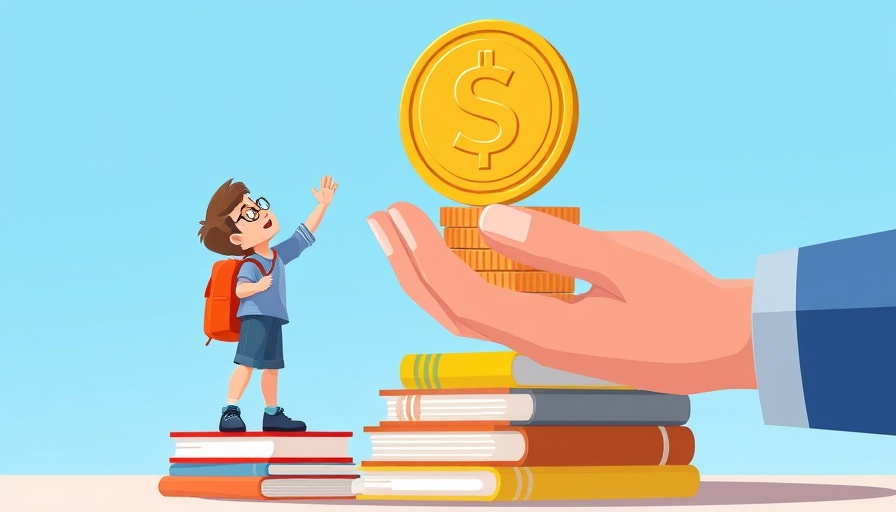
Understanding Student Loans: The Journey Begins
As students prepare to embark on their higher education journey, understanding the implications of student loans is crucial. With tuition costs steadily increasing, student loans have become a necessary avenue for many. This article delves into the essential steps for acquiring a student loan, integrating insights to guide both potential students and their families on making informed financial decisions.
Step 1: Research Your Loan Options Thoroughly
The first step in obtaining a student loan is to comprehend the various options available. Public and private loans provide distinctistic terms, benefits, and drawbacks. Federal student loans typically offer low fixed interest rates and various deferment options that make them a preferred choice. In contrast, private loans might come with stricter criteria and fluctuating interest rates. Understanding these differences not only aids in choosing the right loan but also ensures that you can manage repayment effectively once the studies conclude.
Step 2: Evaluate Financial Needs
Before applying for a loan, it is vital to assess your actual financial needs. This includes tuition, living expenses, and other costs associated with education. The U.S. Department of Education provides a tool for students to calculate necessary funding by considering all potential expenses, ensuring that students borrow only what they genuinely need. This evaluation mitigates future financial strain, allowing for a clearer repayment vision once the educational journey is complete.
Step 3: Fill Out the FAFSA
The Free Application for Federal Student Aid (FAFSA) is a fundamental requirement for accessing federal loans. Completing the FAFSA not only determines eligibility for federal student loans but can also unlock opportunities for grants and scholarships. Many states and educational institutions use FAFSA data to allocate their own financial aid, making it a crucial step in the process. Be proactive; ensure the application is completed as early as possible to maximize financial aid opportunities.
Step 4: Compare Lenders and Loan Offers
Once you have completed the FAFSA, it's time to explore different lenders and loan offers. Engaging in this comparative analysis is key. While federal loans are often more straightforward, private lenders can vary widely in terms of interest rates and repayment conditions. Use online comparison tools to evaluate different lenders, trust community feedback, and speak to current borrowers to gain firsthand insights into the lending experience. This diligence pays off, as secured lower interest rates translate to substantial savings over the duration of the loan.
Step 5: Understand the Loan Terms and Repayment Options
Before signing any loan agreement, familiarize yourself with the terms, interest rates, and repayment options. Different loans come with varying terms: some may require payment while still in school, while others allow for deferment. Understanding these conditions minimizes potential financial distress after graduation. Utilize repayment calculators available through many lenders to forecast monthly payments based on potential salaries in your field of study.
Future Predictions: The Changing Landscape of Student Loans
As states and institutions respond to rising tuition costs, the landscape of student loans is anticipated to evolve significantly. Policy shifts may lead to increased subsidies for low-income students and expanded repayment options, such as income-driven repayment plans that adjust monthly obligations based on income. Prospective students should stay informed on these legislative changes to better navigate their borrowing options.
Counterarguments: Debating the Necessity of Student Loans
While student loans are crucial for many, some experts argue that the education system's heavy reliance on loans is a negative trend, increasing graduates' debt burdens and affecting life choices, such as home buying and savings. This dichotomy fosters valuable discussions about education funding in the U.S. and calls for reformed solutions to reduce the economic pressure on students. Engaging in these discussions and advocating for policy change can empower future generations to pursue education without the burdensome debt.
Final Thoughts: Empowering Informed Decisions
Navigating the world of student loans requires extensive preparation and research. Whether you are a student or a guardian, understanding your financial landscape is essential. By following these steps and staying informed about current trends and policies, you can make sound decisions that will lead to a less burdensome financial future.
Take Action!
As you embark on your journey to secure a student loan, start your research today. Investigate different lenders, complete your FAFSA early, and understand the terms of any loans you consider. Your financial future begins now—make empowered decisions that will benefit you for years to come.
 Add Row
Add Row  Add
Add 




Write A Comment